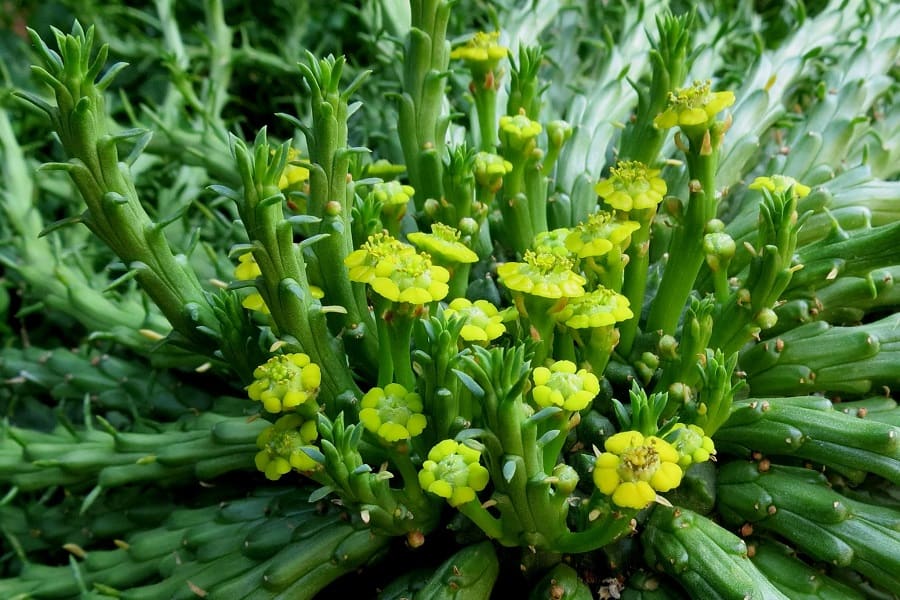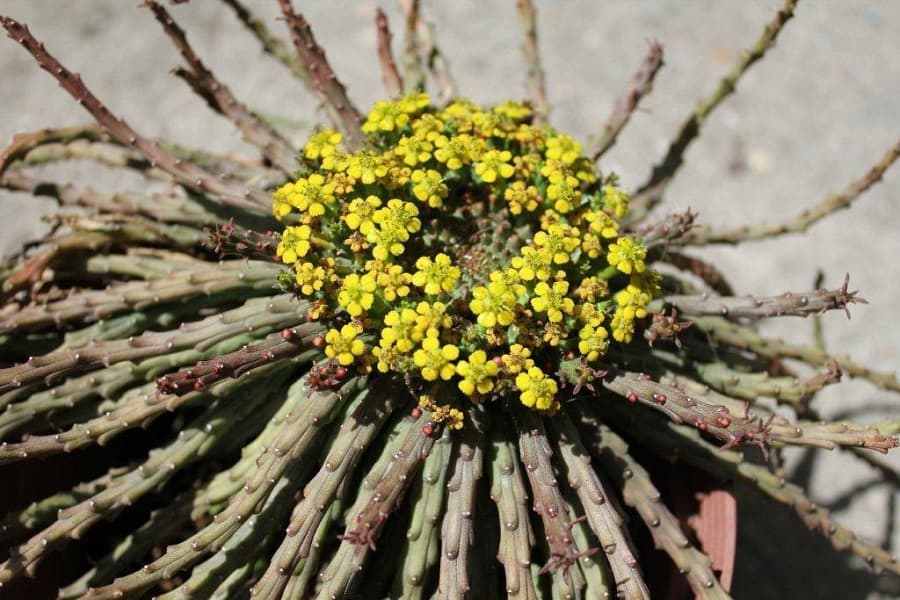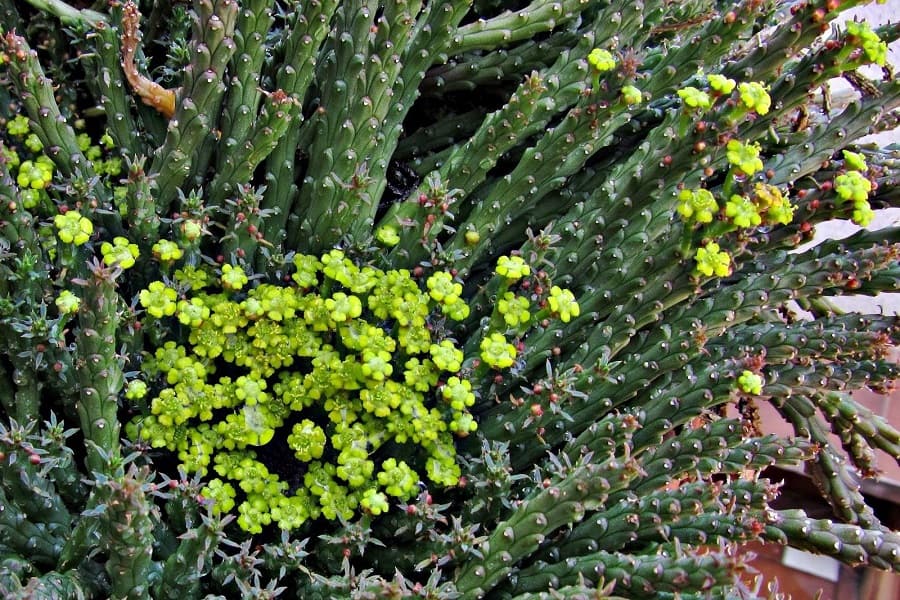Euphorbia flanaganii: The Unsung Hero of Low-Maintenance Houseplants
Picture this: a quirky, snake-like plant that’s virtually indestructible and thrives on neglect. Sound too good to be true? Meet Euphorbia flanaganii, the unsung hero of low-maintenance houseplants. This drought-tolerant beauty is about to become your new gardening obsession!
Native to the arid regions of South Africa, the Canary Islands, and the Arabian Peninsula, Euphorbia flanaganii is a small, dwarf shrub with swollen, underground stems and thorny branches that resemble slithering serpents. Its tiny leaves, measuring up to 3/8 inch in length and 1/16 inch in width, add to its unique, otherworldly charm. But don’t let its diminutive size fool you – this plant packs a punch when it comes to hardiness and ease of care.

Read also:
200 Types of Euphorbia With Pictures
Contents
Euphorbia flanaganii Care Guide
Light Requirements
Like most succulents, Euphorbia flanaganii thrives in bright, direct sunlight. Outdoors, it prefers a sunny spot that receives at least 6 hours of direct sunlight daily. Indoors, it should be placed near a south-facing window to ensure it gets ample sunlight throughout the day. If you’re unable to provide enough natural light, consider investing in a high-quality grow light designed specifically for succulents.

Watering Needs
One of the key advantages of Euphorbia flanaganii is its remarkable drought tolerance. During its active growing season from spring to fall, water the plant when the top 2 inches of soil are completely dry, which typically occurs once a week. In the winter months, when the plant is dormant, reduce watering to once a month or whenever you notice signs of wilting. The best time to water is in the morning, allowing the plant to absorb moisture before the heat of the day.
Soil
Euphorbia flanaganii thrives in well-draining soil that mimics its native, arid environment. A specialized succulent potting mix is ideal, as it provides excellent drainage and airflow. If you prefer to make your own mix, combine equal parts potting soil, coarse sand, and perlite or pumice. The addition of sand and perlite helps prevent soil compaction and ensures excess moisture can easily escape.
Fertilizer
While Euphorbia flanaganii is relatively low-maintenance when it comes to fertilizing, a light application of fertilizer during the growing season can promote healthy growth and vibrant blooms. Use a balanced, water-soluble fertilizer diluted to half-strength, or a gentle, slow-release fertilizer formulated for succulents and cacti. Fertilize once every 4-6 weeks during spring and summer, avoiding fertilization during the winter dormancy period.

Climate
Euphorbia flanaganii is well-adapted to warm, arid conditions. It thrives in temperatures ranging from 70°F to 80°F during the day and 55°F to 65°F at night. While it can tolerate low humidity levels, aim for at least 50% relative humidity for optimal growth. If grown indoors, ensure proper air circulation and consider using a humidifier during dry seasons.
Pests and Diseases
Like many succulents, Euphorbia flanaganii is relatively resistant to pests and diseases when grown in suitable conditions. However, it can occasionally fall victim to spider mites or mealybugs. Regular inspections and prompt treatment with insecticidal soap or neem oil can help control infestations. Root rot may occur if the plant is overwatered or planted in poorly draining soil, so ensure proper drainage and watering practices.
Pruning
Euphorbia flanaganii generally maintains a compact, tidy shape without excessive pruning. However, you can prune to remove any damaged, discolored, or leggy growth as needed. Use clean, sharp pruners or scissors and make cuts just above a leaf node or branching point. Pruning can also help encourage bushier, more compact growth.
Repotting
Euphorbia flanaganii prefers to be slightly root-bound, so repotting should only be done every 2-3 years, or when the plant has outgrown its current container. Choose a pot with ample drainage holes, and use a well-draining succulent or cactus potting mix. Gently remove the plant from its current pot, carefully untangling any circling roots, and replant at the same depth in the new container. Water sparingly after repotting to avoid root rot.
Euphorbia flanaganii Propagation Guide
Euphorbia flanaganii is remarkably easy to propagate, making it a cinch to share with friends or expand your collection. Whether you prefer the tried-and-true method of stem cuttings or the excitement of growing from seed, this versatile succulent is up for the challenge.
Stem Cuttings
- Using a clean, sharp knife or pruners, take 4-6 inch cuttings from the plant’s branching points.
- Allow the cuttings to callus over for 2-3 days by placing them in a dry, shaded area. This helps prevent rot.
- Prepare a well-draining succulent or cactus soil mix in a clean pot with drainage holes.
- Plant the calloused cuttings, burying about a third of their length in the soil.
- Water sparingly, just enough to slightly moisten the soil.
- Place the pot in a bright, warm location, and within 4-6 weeks, you should see new growth emerging from the cuttings.
Seeds
- Obtain fresh Euphorbia flanaganii seeds from a reputable source.
- Fill a well-draining seed tray or pot with a commercial seed-starting mix or a blend of equal parts potting soil and coarse sand.
- Sow the seeds on the surface of the soil, spacing them about an inch apart.
- Cover the seeds with a thin layer of soil, no more than 1/4 inch deep.
- Water gently, being careful not to displace the seeds.
- Place the tray or pot in a warm, bright location, and maintain consistent moisture until germination occurs, which can take anywhere from 2 weeks to 6 months.
- Once seedlings emerge, provide bright, indirect light and water only when the soil is nearly dry.
With its ease of propagation and captivating appearance, Euphorbia flanaganii is a must-have for any succulent enthusiast or aspiring plant parent. So why not give it a try and watch these fascinating plants thrive under your care?
